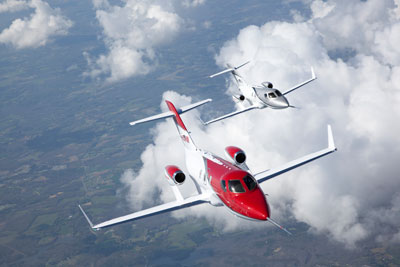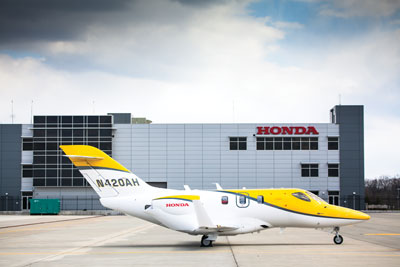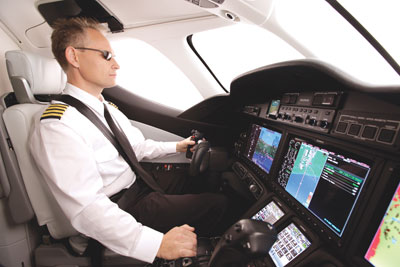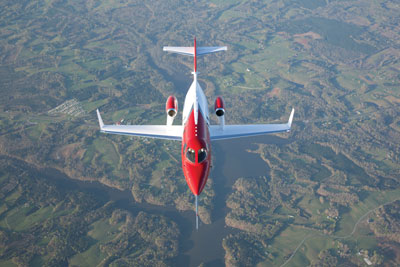
Features
Operations
Driven To Succeed
Honda describes itself as a mobility company. The Honda brand is to be found everywhere in Canada, including roads and crowded highways, waterways and front lawns.
May 8, 2012 By David Carr
Honda describes itself as a mobility company. The Honda brand is to be found everywhere in Canada, including roads and crowded highways, waterways and front lawns. With the end in sight for certification of the HA420 – branded the HondaJet – one of the world’s largest automakers is revving up to claim a piece of the skies in one of the most ambitious pivots from land to air since Bombardier launched the Challenger.
 |
|
| HondaJet teamed with GE Aviation in 2004 to build and support engines and derivatives for the 1,000 to 3,500 pound thrust class. PHOTO: Honda AIRCRAFT Company
|
The Honda Aircraft Company (HAC) will not flood the heavens the same way its parent has the earth. Still, the Japanese airframer, based in Greensboro, N.C., is betting that performance flowing from unique design features such as a natural laminar-flow, over-the-wing mounted engines, lightweight, all-composite fuselage, spacious cabin and $4.5 million sticker price, will give HondaJet a competitive edge as demand for aircraft in the small jet category returns.
Honda is promising a quieter engine, about 20 per cent improved fuel economy and operational costs per hour markedly lower than small jet rivals, bringing the HondaJet within striking distance of the cost of five or six passengers flying commercial.
“We’re doing with HondaJet what the Civic did for [North American] cars from the 1960s,” Michimasa Fujino, the chief executive and HondaJet designer told reporters at Honda’s Tokyo automotive headquarters. “Our competitors are still producing with technology from the 1990s.”
 |
|
| The HondaJet family with its new yellow jet (F3), the third conforming jet to fly. It is going through additional testing now and was set to make its maiden flight just days before EBACE. Later this year, the company plans to launch F4, with production of the first HondaJet to follow next year.
|
That might be so, but the genesis of the HondaJet goes back even further. Fujino, a graduate of Tokyo University with a degree in aeronautical engineering, was chafing under the Japanese aircraft industry’s licensed manufacturing business model in the mid-1980s when Honda sent him to Mississippi State University to study advanced aeronautics.
Honda partnered with Mississippi State to develop the MH02 test aircraft and precursor to the HondaJet in 1993. The all-composite, six-passenger twin jet featured many of HondaJet’s design innovations, including the unconventional mounting of its Pratt & Whitney Canada JT15D turbofans above a forward swept wing. The MH02 accumulated 170 test hours before Fujino and his team had squeezed all the data they could from the airframe and the test program was suspended in 1996.
One year later, Honda produced a concept design for the HondaJet. Not everybody was onboard. Fujino had to fight for the airplane in a challenging boardroom battle with several directors skeptical about the company’s foray into aviation. Another six years would pass before the first HondaJet took flight on Dec. 3, 2003, from Greensboro Piedmont Triad International Airport, two weeks ahead of the 100th anniversary of the Wright brothers’ first flight at Kitty Hawk.
HAC current has three FAA design-conforming jets in the flight test program. The first FAA conforming HondaJet flew in December 2010. An additional two aircraft will join the program later this year in flight test and one more as a ground test airframe.
“We are extremely pleased with the strong performance of the FAA conforming HondaJet,” Fujino said.
“Our flight tests indicate the aircraft is handling and performing as expected, with excellent control harmony and stability.”
 |
|
| Honda is also hoping to cash in on a trend more familiar to its automotive division, where customers are downsizing equipment for improved fuel efficiency.
|
Honda reports the airplane has achieved key benchmarks that have either met or exceeded design performance goals, including reaching a maximum speed of 425 knots true airspeed (KTAS) at 30,000 feet, surpassing the company’s performance commitment of 420 KTAS. The HondaJet has also achieved a climb rate of 4,000 feet per minute, beating its target of 3,990 feet per minute, and a maximum operating altitude of 43,000 feet.
Despite satisfaction with the program’s development, first deliveries have continued to be pushed back. The most recent delay was caused by minor damage to the GE Honda Aero HF120 fan blades during an on-ground ice-ingestion test in Wisconsin last year, forcing a redesign of the engine fan. FAA engine certification is expected this fall with first deliveries of aircraft beginning in mid-2013, almost three years behind schedule.
Delays have renewed speculation the project was too ambitious and the program is in trouble. The design is an ambitious one geared to a single selling point: building a small business jet that does not minimize the size of the cabin.
“The cost of a business jet is very high,” Fujino said. “To reduce the size of the cost you have to reduce the size of the aircraft. But then you sacrifice comfort. I wanted to make the aircraft smaller, but not sacrifice the cabin.”
To support his vision, Fujino had to rethink the placement of the engines, which meant knocking a design taboo of installing engines over-the-wing on its head. “We were taught never to put anything above the wing. It’s the first lesson,” Fujino said at the open house.
Indeed, the only production civil aircraft to feature over-the-wing mounted engines was the VFW-Fokker 614, a 44-passenger regional jet developed in the 1970s. The program was a commercial bust and was cancelled in 1977 having sold only 10 aircraft to three airlines and the German Luftwaffe.
Mounting engines on the wing maximizes cabin space by removing the engine support structure from the fuselage. However, ground clearance prevents engine installation on a business jet below the wing, and nacelles mounted above the wing create an aerodynamic interference that increases drag, especially at high speed. After extensive testing in Boeing’s transonic wind tunnel in 1999, Fujino and his engineering team were able to pinpoint the precise location for the nacelle on a contoured pylon that pushes the engine almost behind the wing.
“This over-the-wing nacelle configuration reduces the cruise drag at transonic speeds without altering the original geometry of the natural-laminar flow wing,” Fujino co-wrote in a technical paper for Honda R&D Americas. HAC claims that the configuration achieves even lower drag than the conventional rear-fuselage engine mount design.
 |
|
| The HA420 will have a maximum speed of 420 knots true airspeed (KTAS) at 30,000 feet, and a maximum operating altitude of 43,000 feet.
|
Drag is also reduced by HondaJet’s natural-laminar flow (NLF) design. The larger the laminar flow in the boundary layer of the wing surface, the lower the drag becomes. Honda designed the SHM-1, a 15 per cent thick, NLF airfoil, which employs integral, machined panels that simplify the manufacturing process by minimizing the number of parts required. Avcorp of Delta, B.C., will supply HondaJet’s wing structural subassembly.
Fuselage construction also contributes to the larger interior cabin space. The HondaJet employs a combination of co-cured integral structure and honeycomb sandwich structures to produce a lighter fuselage structure and lower fuel consumption.
Honda is the world’s largest engine manufacturer, producing more than 20 million engines a year for automobiles, motorcycles, generators, power boats, and lawn and garden equipment. For Honda, the company teamed with GE Aviation in 2004 to build and support engines and derivatives for the 1,000 to 3,500 pound thrust class. The HF120 turbofan engine is a redesign of Honda’s original HF118 power plant resulting in higher thrust, greater fuel efficiency and lower noise and emissions. “The HF120 engine has demonstrated that it is meeting design objectives for thrust, fuel burn and operability,” Bill Dwyer, president of GE Honda Aero Engine confirmed.
The engine’s high thrust-to-weight ratio allows for both long-range and large payload. Specialized fluid dynamics software optimizes airflow within the compact engine to maximize performance, and a high-performance combustion chamber keeps emission levels well within requirements for compact jets.
Thirteen HF120 engines and two core builds are part of certification testing. By the time the engine is certified it will have completed more than 15,000 cycles of ground and flight testing.
While development delays have enabled HAC to sidestep the latest market downturn, they have also erased the lead HondaJet had over direct competitors such as the Embraer Phenom 100, and more recently, the Cessna M2. Embraer and Cessna currently dominate the 200-aircraft-a-year small business jet market. The M2 is a light business jet intended to fill the gap between the Citation Mustang and CJ family. The first flight of the M2 took place March 9, with deliveries scheduled for the second half of 2013, roughly the same time as HondaJet.
HAC is tight lipped about the aircraft’s order book. The airframer says it has orders for more than 100 aircraft, although that figure has not budged since NBAA 2006, when the company announced sales of more than 100
HondaJets in three days.
Fujino may have tipped his hand in Tokyo when he told reporters that the company expects to manufacture 80 aircraft a year in 2013 and currently has a three-year order backlog.
The bulk of orders appears to have come from Europe and North America, including Canada, although HAC is expected to accelerate its entry into emerging markets such as China, Brazil and the Middle East where demand could grow small-jet deliveries to 300 aircraft a year.
Honda is also hoping to cash in on a trend more familiar to its automotive division, where customers are downsizing equipment for improved fuel efficiency. “Most of our customers are owners of small- and medium-sized businesses, and many are looking to get the most out of the jets that they need,” Fujino
said.
The author relied on technical papers by Michimasa Fujino and Yuichi Kawamura for parts of this article.